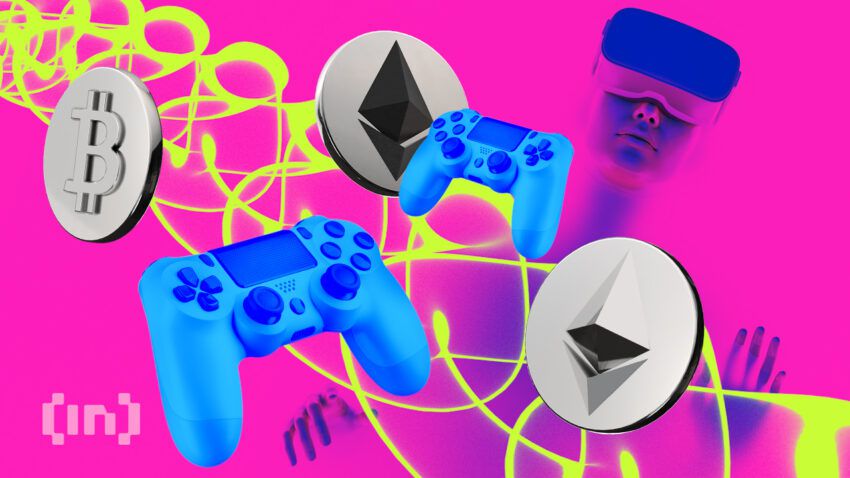Play-to-Die: New Crypto Gaming Model Makes Death in the Metaverse Real

Play-to-Die: What if death in crypto gaming could become permanent, just in the same way as it is in real life? It would “open all new kinds of experiences and gameplay.” This is according to crypto researcher and investor Dave Stanton.
Stanton put forward what seems to be a wild idea. It is play-to-die. He wants to build a system which allows a beloved character that dies in one game to die forever. The character is minted as a non-fungible token (NFT) that can be bought or sold on the open market.
Once the character dies, it burns the NFT.
“ believe that the value potential of NFT characters is much greater than traditional game characters,” Stanton wrote in a blog. “Thus, introducing a concept of loss by dying in game is much more interesting and engaging than before.”
Play-to-Die: Dead but alive as an NFT
Death is not a new concept in gaming, so play-to-die could be an easy transition. Characters in first-person shooter games, or FPS, as well as those in role-playing games (RPG) “die” in the game. Players get a certain number of lives, either a limited amount or infinite.
However, the existing idea is of death in gaming represents nothing more than “a feedback mechanism that you have performed poorly in a certain aspect of the gameplay.” In real life, when you die “it’s game over for good.” When you play-to-die, you die.
Stanton believes the actual death experience could be applied to cryptocurrency gaming. He hopes this “will unlock new experiences in gameplay, new opportunities for gamers to earn and potentially create some of the most enticing spectator experiences.”
NFTS
His plan revolves around non-fungible tokens, immutable and unique units of data stored on the blockchain. NFTs can be used to represent items such as photos, videos, audio, and other types of digital files. And now dead characters in the gaming metaverse.
“NFTs can be bought, sold, traded, or used in other contexts outside of just one game,” he said. “These points are significant… compared to previous game experiences. Instead of only being able to use the character in that game, a player can now buy/sell on the open market.”
Stanton also spoke about the growth of NFTs that can be shared and traded across different blockchains. “It means characters will have much more value (not just monetary value but emotional value to the player) because they are not tied to a single game,” he explained.
“This interoperability could manifest in many ways. Being able to use a character in multiple games is an obvious one. I think there could also be promotional partnerships, membership opportunities and many more we can’t imagine at the moment,” added Stanton.

How does it work?
Non-fungible tokens have brought up novel possibilities in the curation and circulation of art. They have elicited endorsements from pop celebrities such as Snoop Dogg, Paris Hilton, and Madonna.
Considered by some as the wild west of the blockchain industry, non-fungible tokens have also started to draw criminals into the industry. Issues of rug-pulls are commonplace. Users have also lost thousands of NFTs worth millions of dollars in phishing attacks.
In his proposal, Dave Stanton theorizes how permanent death in crypto gaming could work. He imagines a first-person shooter combat game or other fighting or battle game. In this game, a player’s character is an NFT.
As one wins battles, they accrue skills. However, if you lose a battle your character dies and it burns the NFT. What could this mean?
“If the game was very popular, any player could start from nothing and purely on merit build up a highly skilled character,” Stanton detailed.
“Theoretically, highly skilled characters would be rare since many would die all the time in game. They can then play with this character or sell it to someone who wants a skilled fighter but doesn’t want to put in the work to achieve it.”
Stanton argued that this could create “earning opportunities for good gamers with little to no capital. Rarity is not random (like with current NFT mints) but based on skill, effort and survival.”
“I think there’s also an opportunity for skins or items to be only unlocked by reaching certain levels or surviving a certain number of battles. This would create additional value for these characters beyond just the skills in the game,” he added.
Dying while gaming
Dying in a game means players lose their character. Stanton said players “may become even more engaged and attached to their characters being extra thoughtful about their actions. This can lead to much more engaged gamers.”
Stanton’s plan means there is a possibility that “spectators will become more attached to various highly skilled long lasting characters.” He explained:
“Streaming fights/battles could attract many more viewers within gaming and more importantly, outside of it. Similar to how the biggest sports events in the world (Super Bowl, World Cup, Olympics etc) get fans of the sport to watch as well as many ‘non-sports fans’. [This is] because of the scale of interest in these events and impact it has on pop culture. Since the characters will ‘die’ in game if they lose, it elicits much more emotion for spectators and could be more interesting than current games.”
Risky proposal
Not everyone is as thrilled with Stanton’s idea. Long Do, game director at NFT pixel art play-to-earn gaming platform Anomura, told BeInCrypto that the concept of permanent death in crypto gaming was weak.
“The weakness of the model is that most investors want to see models where there is little risk and huge upside,” said Do.
“For example, projects where there is no cost for investors to mint, but a huge upside if the secondary sales go viral and the floor price allows them to profit. This sort of model goes against that current thinking. From a gamification [point of view] it might make sense for those with higher risk tolerance. There is an audience for this, but it might not be perceived very well by traditional investors in web3.”
Dave Stanton acknowledged the failure of past experiments with permanent death in the gaming world.
However, “if this is adopted in crypto gaming, we will see many new low barrier to entry merit based economic opportunities for gamers.” Also, there is “potential [for a] revolution in game viewing because it will feel more real and visceral to non-gaming spectators. Similar to how sports fans feel watching a game knowing the athletes are putting their bodies and in some cases like with motor sports and combat sports, their lives on the line.”
Crypto gaming leads Web3 growth
According to DappRadar, the blockchain gaming industry continued to see significant growth during the third quarter of 2022.
The number of unique active wallets in the sector rose by 8%, or 912,000, month-over-month, ensuring its share of Web3 remained at over 48% in Q3. Gameta was the most used dapp in September, with over 1.33 million unique wallets.

Move-to-earn gaming projects are gaining popularity, it said. The Sweat Economy minted a record-breaking 10,000 NFTs on Near Protocol. Blankos Block Party and Star Atlas, online NFT games, became the first Web3 titles to be released on the Epic Games Store.
Gods Unchained climbed into the top five collections by NFT trading volume. It recorded over $18 million in sales in September. Investments in blockchain-based games and Metaverse projects declined in Q3 ($1.3 billion) compared to Q2, a decrease of 48%.
However, this is almost double the total amount of money raised for the whole of 2021. In its Q3 report, DappRadar stated: “Blockchain gaming’s future is bright, and it is on track to become the frontrunner for Web3.”






 Bitcoin
Bitcoin  Ethereum
Ethereum  Tether
Tether  USDC
USDC  TRON
TRON  Dogecoin
Dogecoin  Cardano
Cardano  Bitcoin Cash
Bitcoin Cash  Chainlink
Chainlink  Zcash
Zcash  Monero
Monero  LEO Token
LEO Token  Stellar
Stellar  Litecoin
Litecoin  Hedera
Hedera  Dai
Dai  Cronos
Cronos  Tether Gold
Tether Gold  OKB
OKB  Ethereum Classic
Ethereum Classic  KuCoin
KuCoin  Gate
Gate  Algorand
Algorand  Cosmos Hub
Cosmos Hub  VeChain
VeChain  Dash
Dash  Tezos
Tezos  TrueUSD
TrueUSD  Stacks
Stacks  IOTA
IOTA  Decred
Decred  Basic Attention
Basic Attention  Theta Network
Theta Network  NEO
NEO  Synthetix
Synthetix  Qtum
Qtum  Ravencoin
Ravencoin  DigiByte
DigiByte  0x Protocol
0x Protocol  Nano
Nano  Zilliqa
Zilliqa  Holo
Holo  Siacoin
Siacoin  Numeraire
Numeraire  Waves
Waves  Ontology
Ontology  Status
Status  BUSD
BUSD  Enjin Coin
Enjin Coin  Hive
Hive  Pax Dollar
Pax Dollar  Lisk
Lisk  Steem
Steem  Huobi
Huobi  NEM
NEM  OMG Network
OMG Network  Bitcoin Gold
Bitcoin Gold  Augur
Augur  HUSD
HUSD